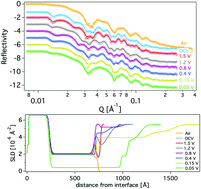Role of conductive binder to direct solid–electrolyte interphase formation over silicon anodes†
Abstract
With the use of in situ neutron reflectometry (NR) we show how the addition of an electronically conductive polymeric binder, PEFM, mediates the solid–electrolyte interphase (SEI) formation and composition on an amorphous Si (a-Si) electrode as a function of the state-of-charge. Upon initial contact with the electrolyte a Li rich, 41 Å thick, layer forms on the surface of the anode below the polymer layer. At 0.8 V (vs. Li/Li+), a distinct SEI layer forms from the incorporation of electrolyte decomposition products in the reaction layer that is organic in nature. In addition, solvent uptake in the PEFM layer occurs resulting in the layer swelling to ∼200 Å. Upon further polarization to 0.4 and 0.15 V (vs. Li/Li+) a thick layer (800 Å) on the surface of the Si is evident where a diffuse interface between the PEFM and SEI occurs resulting in a matrix between the two layers, as the binder has taken up a large amount of electrolyte. The two layers appear to be interchanging solvent molecules from the PEFM to the SEI to the Si surface preventing the lithiation of the a-Si. By 0.05 V (vs. Li/Li+) a Li rich, 72 Å thick, SEI layer condenses on the surface of the anode, and a 121 Å intermixed layer on top of the SEI with LiF and Li–C–O species is present with the rest blended into the electrolyte.



 Please wait while we load your content...
Please wait while we load your content...
